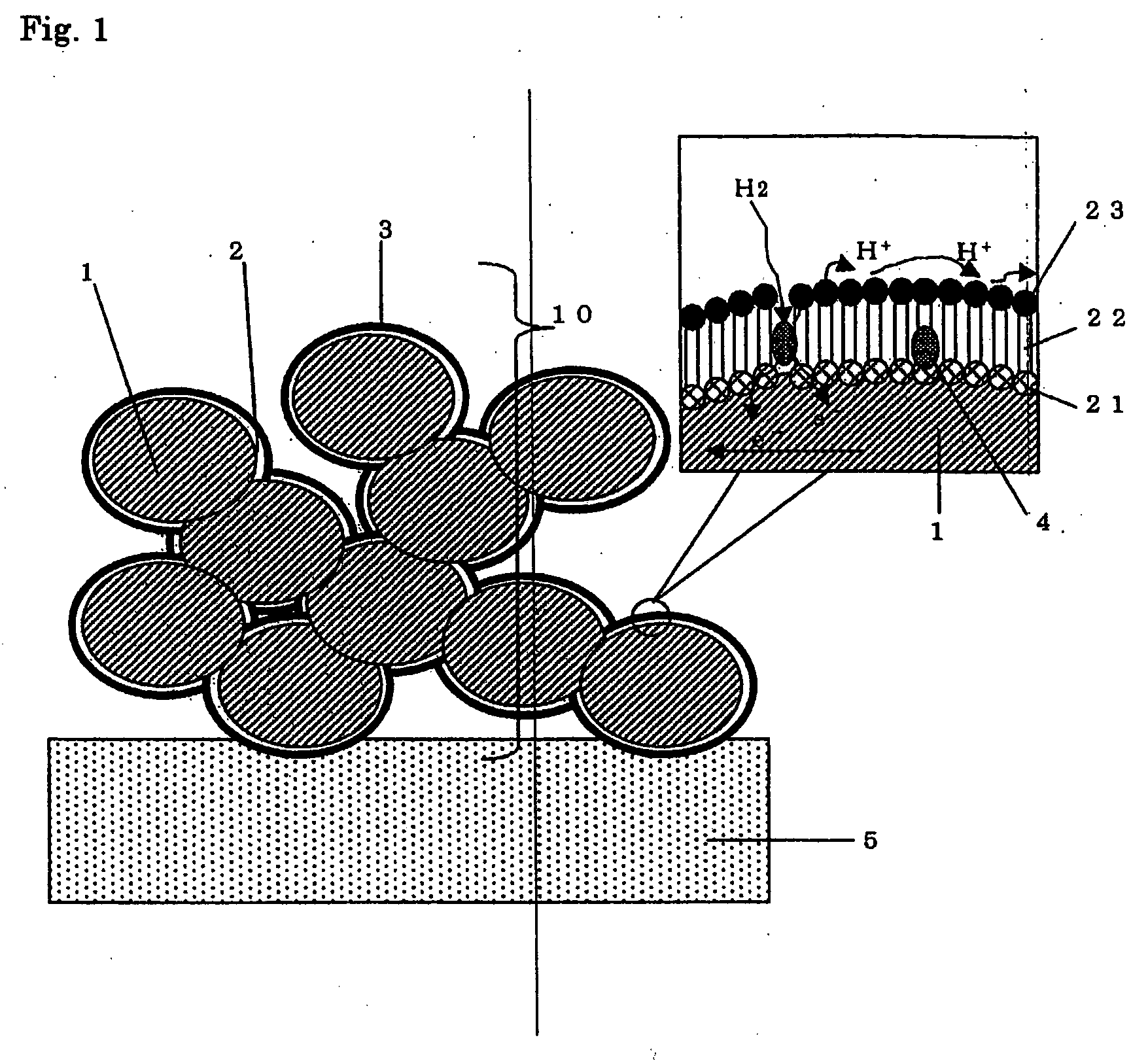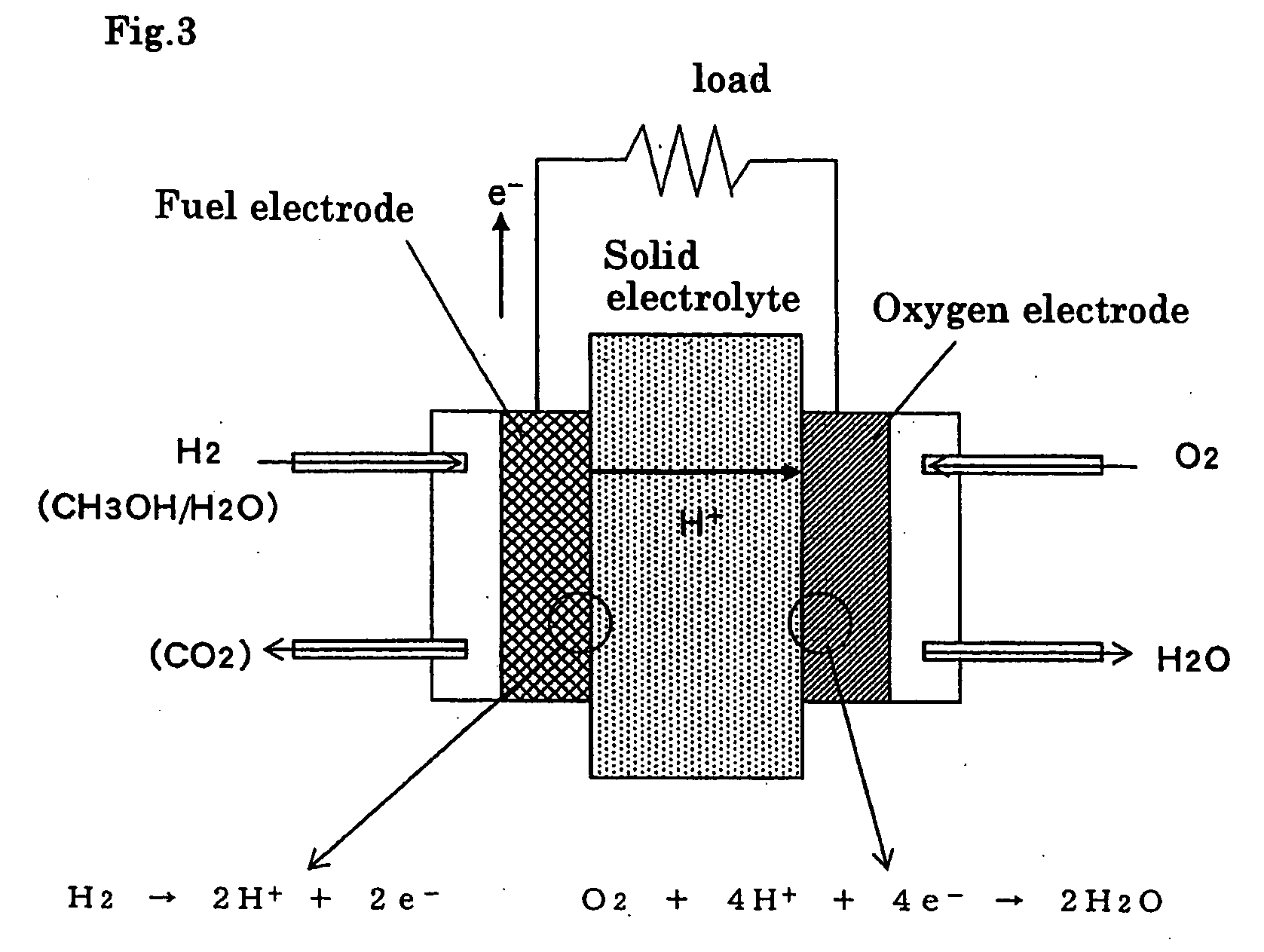Porous electrode, and electrochemical element made using the same
a technology of electrochemical elements and porous electrodes, applied in the field of porous electrodes, can solve the problems of less catalysts being used, increased cost, and inefficient reaction, and achieve the effect of accelerating reaction
- Summary
- Abstract
- Description
- Claims
- Application Information
AI Technical Summary
Benefits of technology
Problems solved by technology
Method used
Image
Examples
example 1
[0129] A porous material with a specific surface area of about 50 m2 / g was obtained by compression molding of carbon black with an average particle size of 0.1 μm.
[0130] Meanwhile, the spherical molecules used as a spacer were prepared as follows. A polyamide-amine dendrimer (Generation 4) having hydroxyl groups on the surface (available from Aldrich) was added to methanol, and the resulting solution (0.1 mmol / L) was mixed with a platinum ammonium aqueous solution (3 mmol / L) so that the interior of the dendrimer was impregnated with the platinum ammonium. This product was then subjected to hydrogen reduction at 180° C., which formed platinum particles with an average size of 2 nm inside the dendrimer, and yielded a catalyst-supporting dendrimer. The catalyst-supporting dendrimer thus obtained was mixed with a polyamide-amine dendrimer (Generation 4.5) having carboxyl groups on the surface (available from Aldrich) in a molar ratio of 1:50, and water was added to the mixture. The dia...
example 2
[0135] A porous material was prepared by forming an electroless plating layer of gold in a thickness of approximately 20 nm on the surface of porous silica with an average pore diameter of 0.1 μm, a specific surface area of 200 m2 / g, and a density of 400 kg / m3.
[0136] Meanwhile, a solution was prepared by dissolving a disulfide compound having a molecular structure of (S—(CH2)15—COOH)2 to acetone such that its concentration would be 50 mmol / L. The catalyst-supporting dendrimer of Example 1 was then added to this solution so that the concentration would be the same as above. The porous material was immersed in this solution, which formed a monomolecular film on the surface of the porous material because the disulfide groups coordinate to the gold in self-organizing fashion. As a result, the surface of the obtained porous electrode was covered with carboxyl groups. Since the platinum (catalyst) particles here were present at the porous material surface, the dendrimer containing the ca...
example 3
[0138] The porous material in this case was a fired porous material, produced by compression molding titanium oxide particles with an average size of approximately 100 nm, and then firing this molded article.
[0139] Meanwhile, a solution was prepared by dissolving γ-(2-aminoethyl)aminopropylmethoxysilane (used as a silane coupling agent) in a concentration of 50 mmol / L in isopropyl alcohol. A platinum colloid with a particle size of 2 nm was dispersed in this solution. The porous titanium oxide was immersed in this dispersion to obtain a porous electrode on the surface of which was formed a monomolecular film comprising silyl groups chemically bonded to titanium oxide. Because the surface of the porous material was covered with amino groups, and the platinum colloid was present without agglomerating on the porous material surface, it was believed that this colloid catalyst had been incorporated into an organic layer of a monomolecular film. The amount of catalyst supported here was ...
PUM
 Login to View More
Login to View More Abstract
Description
Claims
Application Information
 Login to View More
Login to View More - R&D
- Intellectual Property
- Life Sciences
- Materials
- Tech Scout
- Unparalleled Data Quality
- Higher Quality Content
- 60% Fewer Hallucinations
Browse by: Latest US Patents, China's latest patents, Technical Efficacy Thesaurus, Application Domain, Technology Topic, Popular Technical Reports.
© 2025 PatSnap. All rights reserved.Legal|Privacy policy|Modern Slavery Act Transparency Statement|Sitemap|About US| Contact US: help@patsnap.com



